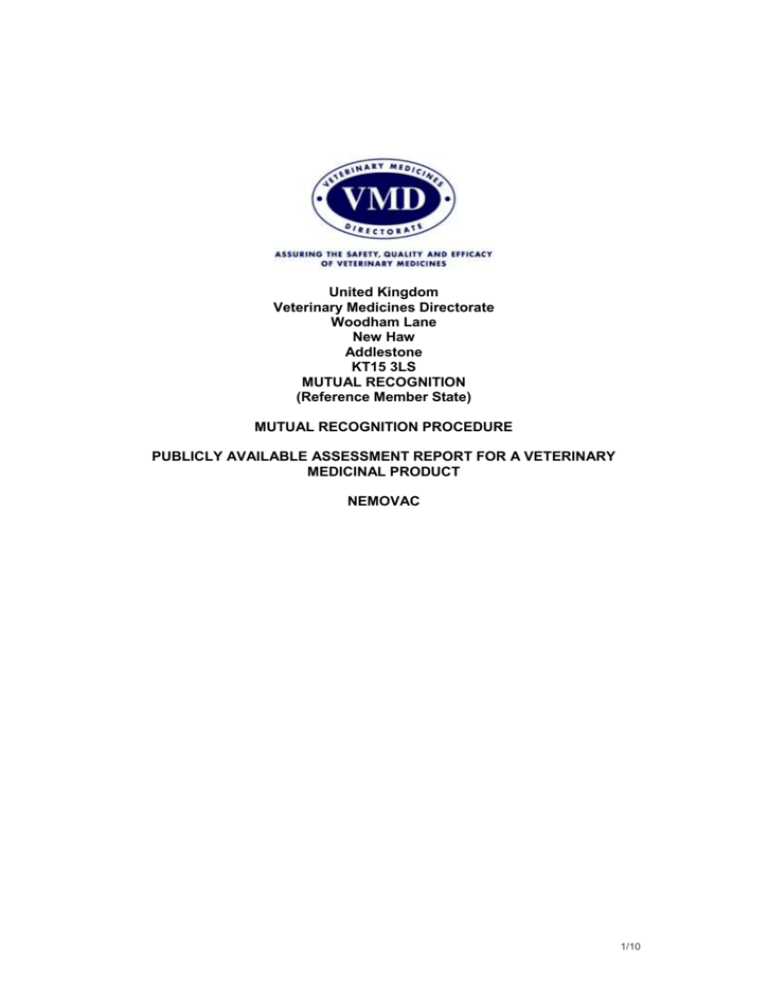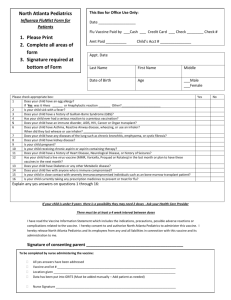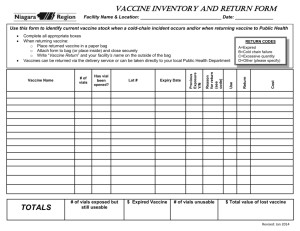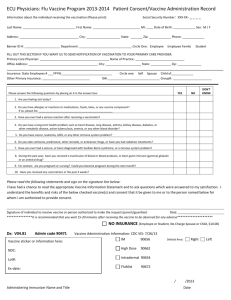United Kingdom Veterinary Medicines Directorate Woodham Lane
advertisement

United Kingdom Veterinary Medicines Directorate Woodham Lane New Haw Addlestone KT15 3LS MUTUAL RECOGNITION (Reference Member State) MUTUAL RECOGNITION PROCEDURE PUBLICLY AVAILABLE ASSESSMENT REPORT FOR A VETERINARY MEDICINAL PRODUCT NEMOVAC 1/10 Nemovac Merial Animal Health UK/V/0133/001/X/001 Application for Mutual Recognition Procedure Publicly Available Assessment Report MODULE 1 PRODUCT SUMMARY EU Procedure number UK/V/0133/001/X/001 Name, strength and pharmaceutical form Nemovac Lyophilisate for oral suspension. At least 2.3 log10 CCID50 per dose. Applicant Merial Animal Health Limited PO Box 327 Sandringham House Harlow Business Park Harlow Essex CM19 5TG Active substance(s) Live pneumovirus strain PL21 ATC Vetcode QI01AD01 Target species Broiler chickens between 7 and 14 days. Breeder and layer pullets from 14 weeks of age. Indication for use For broiler chickens: For active immunisation of chickens to reduce upper respiratory signs associated with avian pneumovirus infection (Swollen Head Syndrome). For breeder and layer pullets: Priming for active immunisation of pullets before booster vaccination with an inactivated vaccine containing avian pneumovirus to reduce respiratory signs associated with avian pneumovirus infection. 2/10 Nemovac Merial Animal Health UK/V/0133/001/X/001 Application for Mutual Recognition Procedure Publicly Available Assessment Report MODULE 2 The Summary of Product Characteristics (SPC) for this product is available on the Heads of Medicines Agencies (veterinary) (HMA(v)) website (www.hma.eu). 3/10 Nemovac Merial Animal Health UK/V/0133/001/X/001 Application for Mutual Recognition Procedure Publicly Available Assessment Report MODULE 3 PUBLIC ASSESSMENT REPORT Legal basis of original application Mutual Recognition application in accordance with Article 12 of Directive 2001/82/EC as amended. Date of completion of the original mutual recognition procedure 27 February 2008 Date product first authorised in the Reference Member State (MRP only) 16 April 1999 Concerned Member States for Austria original procedure Belgium Finland France Germany Greece Ireland The Netherlands Portugal Spain I. SCIENTIFIC OVERVIEW The product is produced and controlled using validated methods and tests which ensure the consistency of the product released on the market. It has been shown that the product can be safely used in the target species. The product is safe for the user, the consumer of foodstuffs from treated animals and for the environment, when used as recommended. Suitable warnings and precautions are indicated in the SPC. The efficacy of the product was demonstrated according to the claims made in the SPC. The overall risk/benefit analysis is in favour of granting a marketing authorisation. II. QUALITY ASPECTS A. Composition The product contains live pneumovirus, PL21 strain, (containing not less than 102.3 CCID50 per dose) and excipients protein hydrolysate, bovine albumin, povidone, disaccharide, polyol, salts. Satisfactory justification for the choice of ingredients and containers has been provided. 4/10 Nemovac Merial Animal Health UK/V/0133/001/X/001 Application for Mutual Recognition Procedure Publicly Available Assessment Report The choice of the vaccine strain is justified. The product is an established pharmaceutical form and its development is adequately described in accordance with the relevant European guidelines. B. Method of Preparation of the Product The product is manufactured fully in accordance with the principles of good manufacturing practice from a licensed manufacturing site. Process validation data on the product were presented in accordance with the relevant European guidelines. C. Control of Starting Materials The active substance contains live pneumovirus, PL21 strain. A description of the control tests carried out in the production of the active ingredient has been provided and are considered satisfactory. Batch testing certificates of three consecutive batches of active ingredient were provided. These demonstrate acceptable reproducibility and compliance with the manufacturing process. Starting materials of non-biological origin used in production comply with inhouse specifications. The materials of biological origin are adequately described with regard to their origin and testing carried out. They are of acceptable quality. The master and working viral seeds have been produced according to the Seed Lot System as described in the relevant guideline. D. Specific Measures concerning the Prevention of the Transmission of Animal Spongiform Encephalopathies Scientific data have been provided and compliance with the Note for Guidance on Minimising the Risk of Transmitting Animal Spongiform Encephalopathy Agents via Human and Veterinary Medicinal Products has been satisfactorily demonstrated. E. Control tests during production The tests performed during production are described and the results of conforming to the specifications are provided. F. Control Tests on the Finished Product The tests performed on the final product conform to the relevant requirements; any deviation from these requirements is justified. The tests include in particular appearance, pH, identification, assay, safety, sterility, extraneous agents, batch to batch consistency and residual humidity. G. Stability Stability data on the finished product have been provided in accordance with applicable European guidelines, demonstrating the stability of the product throughout its shelf life when stored under the approved conditions. An 18 months shelf life has been adequately justified The in-use shelf-life of the reconstituted vaccine is 2 hours at 25°C and is supported by the data provided. 5/10 Nemovac Merial Animal Health UK/V/0133/001/X/001 Application for Mutual Recognition Procedure Publicly Available Assessment Report H. Genetically Modified Organisms Not applicable J. Other Information Not applicable III. SAFETY ASSESSMENT Laboratory trials Pullets The safety of the administration of an overdose and of a repeated dose has been demonstrated by the data originally submitted when the product was authorised for use in broilers chickens only. Since the broilers were younger (714 days rather than 14 weeks) it was considered that they were more sensitive and therefore these data support the following safety requirements: Safety of an administration of an overdose Impact on immunological function Interactions Dissemination and spread in the target species Ecotoxicity and safety in non-target species Safety in field conditions. The safety of the administration of a single dose in pullet chickens is demonstrated in a study. A number of 14 week old female SPF1 chickens were vaccinated by either the oral route or ocular route. The birds received the maximum recommended dose (4.0 log10 CCID50). A number of birds were part of a control group for comparative purposes. A booster vaccination was later given. The birds were observed over a period of 38 weeks. Observations made include body weight, mortality, laying percentage, number of down graded eggs and blood samples. The data provided indicate that the product is safe for use in future layer pullets from 14 weeks of age when administered at the maximum dose by either the oral or ocular routes. Vaccination 4 weeks before the onset of lay did not appear to affect egg productivity. This is reflected on the SPC: One dose of vaccine to be administered at 14 weeks of age before booster vaccination with inactivated vaccine prior to the onset of lay Specific studies were carried out as part of the original submission when the product was granted for use in broiler chickens only. These studies relate to spread, dissemination, reversion to virulence of the vaccine strain. Since the broilers were younger (7-14 days rather than 14 weeks) it was considered that they were more sensitive and therefore these data support the following safety requirements. This is reflected in the SPC: The product is a live vaccine and is excreted from vaccinated birds and so spreads to unvaccinated chickens and turkeys. Reversion to virulence trials carried out in the laboratory have shown that the strain does not revert to virulence neither in chickens nor in turkeys. However, precautionary measures have to be followed in order to diminish the spread, see 4.3, 4.5, 4.9, and 6.6. 1 Specific Pathogen Free 6/10 Nemovac Merial Animal Health UK/V/0133/001/X/001 Application for Mutual Recognition Procedure Publicly Available Assessment Report The safety studies were carried out by oculo-nasal and oral administration and no side effects were observed. It is advised not to vaccinate in the presence of other sensitive species (guinea fowl, pheasant), taking into account the spread of the vaccine strain and the lack of safety data for these species. Residue levels are considered to be acceptable. It is considered that the concentrations would be so low that they would be unlikely to be detected in the edible tissues of chickens at levels that would constitute a risk for the consumer. In consequence a withdrawal period of zero days is appropriate. In terms of the interaction of the vaccine with others, the original safety data in broilers is referred to. Since the broilers were younger (7-14 days rather than 14 weeks) it was considered they were more sensitive and therefore these data support this safety requirement. Levels of interaction were studied after simultaneous vaccination of Nemovac and vaccine strains of Infectious Bronchitis, Newcastle Disease and Infectious Bursal Disease. In terms of safety there is little interaction evident between Nemovac and IB, IBD and ND vaccines. Another interaction study was carried out in broilers to determine whether the administration of a maximum dose of Nemovac interferes with the administration of a minimum dose of a live Newcastle disease vaccine. This study demonstrated the general absence of any reactions when animals received both Nemovac and ND simultaneously or the ND vaccine alone. The study does not exclude the possibility that the duration of immunity may be influenced. Overall conclusions are reflected on the SPC: The laboratory studies have shown that the simultaneous use of the vaccine and Infectious Bursal Disease, Infectious Bronchitis and Newcastle Disease vaccines may slightly decrease or transiently delay the humoral response of animals to NEMOVAC. The simultaneous use of the vaccine and Infectious Bronchitis vaccine may decrease and/or delay the Infectious Bronchitis seroconversion. Therefore, no other vaccines may be given concomitantly with the product Field studies Pullets The Applicant has not conducted field studies in layer and breeder pullets. Instead the original safety data in broilers is referred to. It is considered that since the broilers were younger (7-14 days rather than 14 weeks) they were more sensitive and therefore support this safety requirement. The vaccine has been shown to be safe for administration to chickens. There is a risk that vaccine virus might spread to turkeys, but it appears to pose no risk to turkeys that become infected with the virus. It does not revert to virulence in either species. The vaccine may therefore be considered to be safe for use as recommended. Ecotoxicity 7/10 Nemovac Merial Animal Health UK/V/0133/001/X/001 Application for Mutual Recognition Procedure Publicly Available Assessment Report The laboratory studies indicated that the vaccine strain could be found in the cloaca, and that there is therefore a risk of exposure of the environment via faeces in particular. Investigation of the risk has been carried out by means of studies in turkeys because these are more susceptible to the virus than chickens and were therefore considered to be representative of the species which could potentially be exposed to the vaccine strain in the environment of farms. It was concluded that the concentrations of antibiotics and other constituents of the vaccine are so low that there is no significant risk of exposure of the environment to the residues of these products. Warnings and precautions as listed on the product literature are adequate to ensure safety to the environment when the product is used as directed. IV CLINICAL ASSESSMENT (EFFICACY) Pullets Six studies have been submitted in pullets. Of the six studies, four were based on serology,one was based on challenge and one was based on serology and challenge. A number of studies in broilers were provided previously when the product was first authorised for use in broilers. These were carried out using the vaccine at or close to the minimum dose in broiler chickens. A challenge trial was performed whereby the symptoms seen were very mild however there was a significant improvement in the vaccinated birds. The data support the claim of reduction in clinical signs of respiratory diseases associated with avian pneumovirus infection. The recommended vaccine protocol in pullets is well supported (i.e. Nemovac at 14 weeks of age, then boosting with inactivated vaccine at 18 weeks of age). Demonstration of the duration of immunity in the context of pullets is restricted to that after boosting with inactivated vaccine. The onset of immunity and duration of immunity could be that already authorised as the efficacy of the complete vaccination scheme has already been approved for the booster inactivated vaccine. CONCLUSIONS ON EFFICACY ASPECTS Taking into account the data provided, the indication of this product is justified and included on the SPC and product literature as follows: For broiler chickens: For active immunisation of chickens to reduce upper respiratory signs associated with avian pneumovirus infection (Swollen Head Syndrome). Immunity has been demonstrated 17 days after vaccination and has been shown to persist for a further three weeks. For breeder and layer pullets: Priming for active immunisation of pullets before booster vaccination with an inactivated vaccine containing avian pneumovirus to reduce respiratory signs associated with avian pneumovirus infection. For onset of immunity and duration of immunity of full schedule, see SPC of the inactivated booster vaccine. 8/10 Nemovac Merial Animal Health UK/V/0133/001/X/001 Application for Mutual Recognition Procedure Publicly Available Assessment Report V OVERALL CONCLUSION AND BENEFIT– RISK ASSESSMENT The data submitted in the dossier demonstrate that when the product is used in accordance with the Summary of Product Characteristics, the risk benefit profile for the target species is favourable and the quality and safety of the product for humans and the environment is acceptable. 9/10 Nemovac Merial Animal Health UK/V/0133/001/X/001 Application for Mutual Recognition Procedure Publicly Available Assessment Report MODULE 4 POST-AUTHORISATION ASSESSMENTS The SPC and package leaflet may be updated to include new information on the quality, safety and efficacy of the veterinary medicinal product. The current SPC is available on the Product Information Database of the Veterinary Medicines Directorate website. (www.gov.uk/check-animal-medicine-licensed) The post-authorisation assessment (PAA) contains information on significant changes which have been made after the original procedure which are important for the quality, safety or efficacy of the product. The PAA for this product is available on the Product Information Database of the Veterinary Medicines Directorate website. (www.gov.uk/check-animal-medicine-licensed) 10/10







